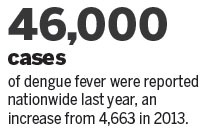Drones help rein in mosquito breeding
Updated: 2015-09-15 08:21
By Zheng Caixiong in Guangzhou(China Daily)
|
|||||||||||
Aerial drones have become part of the prevention effort against dengue fever in Guangdong province, after the epidemic peaked last summer.
In Chaozhou, drones buzz around the skies over Xiangqiao district. Within minutes, they bring back photos of the district's roofs, pinpointing those with pools of water that could serve as breeding grounds for mosquitoes, which spread the disease.
Xiangqiao district reported 257 dengue fever cases as of Saturday.
"Using drones is a new and effective measure to help remove hidden dangers and prevent an outbreak," said a neighborhood committee official, surnamed Zhuang.
According to Zhuang, nine drones are collecting the aerial photos.
The Guangdong Center for Disease Control and Prevention said dengue fever usually peaks in the province between May and November. But the number of cases has sharply dropped this year compared with last year.
Last year, China reported 46,000 cases of dengue fever, with 43,200 were in Guangdong. That's up dramatically from the mere 4,663 cases reported nationwide in 2013.

Experts attribute dengue fever's rise in China to frequent interaction of people with Southeast Asian countries, where incidence of the disease has been climbing. People who travel to affected countries can carry the disease back with them.
Last year, Guangdong had six deaths from dengue fever, according to the provincial disease control center.
Dengue fever is passed to humans by mosquitoes. Symptoms of the flulike disease include headaches, rashes, lethargy and joint and bone pain.
Various measures have been taken to fight the epidemic. Besides the use of drones to pinpoint water pools, 500,000 to 600,000 specially bred male mosquitoes that cause their mating partners to become infertile are being released on an island every week as a test.
Eggs produced by female mosquitoes that mated with wolbachia-bearing males were not viable, researchers found. The technique reduced the mosquito population in some areas of the island by 90 percent, according to a report by Southern Metropolis Daily.
The mosquitoes were produced at a science park "factory" in Guangdong, which opened on July 17.
It has the capacity to produce up to 10 million male mosquitoes every week that are infected with wolbachia, a bacteria that exists widely in many insects, the report said.
zhengcaixiong@chinadaily.com.cn
Related Stories
Dengue fever cases surge in southern Taiwan 2015-09-08 08:38
Mosquitoes released in fight against dengue fever 2015-08-03 07:47
Domestic company's dengue fever test approved 2014-10-09 09:40
Guangdong combats dengue fever epidemic 2014-10-07 08:25
South China province sees 1,279 new dengue fever cases 2014-10-05 22:06
Today's Top News
Cameron urges support for Syrian refugees
Hungary launches border crackdown, says refugees risk expulsion
China, Belgium have great potential in nuclear power generation
Georgian Prime Minister awarded honorary professorship
Border-free Europe unravels in migrant crisis
Refugee crisis: Germany re-imposes border controls
Australia gets new PM as Abbott loses out to rival Turnbull
Egyptian security forces shoot at Mexican tourist convoy, kill 12
Hot Topics
Lunar probe , China growth forecasts, Emission rules get tougher, China seen through 'colored lens', International board,
Editor's Picks

|

|

|

|

|

|






